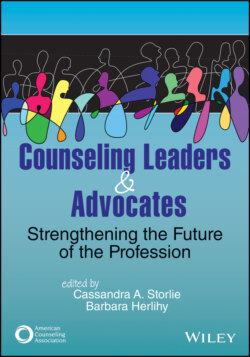Читать книгу Counseling Leaders and Advocates - Группа авторов - Страница 14
Part I: Perspectives on Leadership & Advocacy in Counseling
ОглавлениеPart I highlights current perspectives on leadership and advocacy in our profession. In addition to this chapter, two chapters provide information critical to the growth and development of new counseling leaders. In selecting this framework, we wanted readers to better understand key historical aspects of the development of the counseling profession while also considering the current social climate, particularly the impact of racial and ethnic injustices that have been prevalent throughout U.S. history. Likewise, we wanted newer professionals to have a clearer sense of what leadership and advocacy looks like on the job, to supplement what they had learned in the classroom.
Chapter 2, Culturally Responsive Counseling Leadership and Advocacy, chronicles salient aspects of the history of the American Counseling Association (ACA), including “Operationalization of the Multicultural Counseling Competencies” (Arredondo et al., 1996), the “ACA Advocacy Competencies” (Lewis et al., 2003), and the “Multicultural and Social Justice Counseling Competencies” (ACA, 2015), highlighting how they have led our profession not only in gaining multicultural competence but also in taking it a step further to engage in culturally responsive counseling leadership and advocacy. The growth in the perspective of counselors, moving from being culturally sensitive to becoming culturally responsive, is described through the lens of an ecological systems framework. The chapter authors address the history of the counseling profession and its roots in advocating for individuals and groups who are most marginalized in our society. Through transparency and engagement, the authors provide insights into how one can become a culturally responsive counseling leader and advocate by providing specific action steps in relation to the Black Lives Matter (BLM) movement. Essential characteristics of culturally responsive counseling leaders are also emphasized in this chapter. The chapter concludes with practical applications and describes how counseling students and practitioners can develop into culturally responsive counseling leaders and advocates.
Chapter 3, Leadership and Advocacy in the Field, describes how counselors advocate for their clients within the complex communities in which they reside. The chapter authors present a historical perspective that demonstrates how client advocacy has been the prominent focus for practicing counselors from the inception of our profession. Professional advocacy, which developed over time as counselors gained a sense of professional identity separate from other mental health professions, is also highlighted as a way to both unify and strengthen the counseling profession. The authors discuss how leadership and advocacy are inherently related and how advocacy initiatives taken on by counseling leaders affect our world today. Information on how to engage in the types of ground-level leadership that takes place daily within K–25 educational settings, clinical mental health and community settings, and counseling programs and universities is provided. The authors conclude by describing how counseling students and counseling practitioners can develop into servant leaders.
